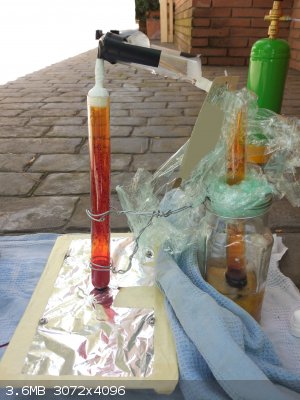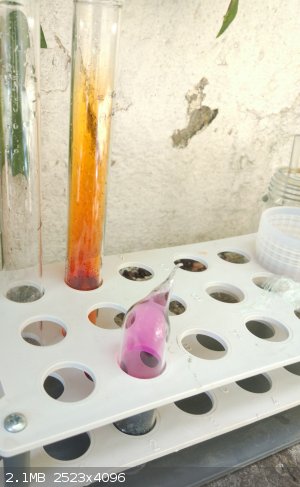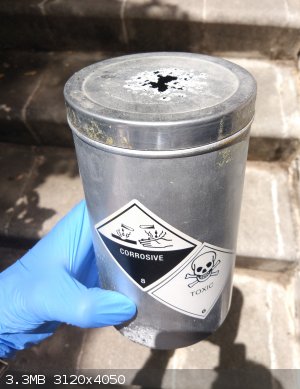Non-wetting bromine sample
I've been wanting for some time to have a bromine sample that doesn't stick to glass. Even thought my starting point is reagent grade bromine it's
quite old and has since absorbed some water so if I just ampule it, it sticks to glass.
When I was searching around how to obtain bromine that doesn't wet glass the common knowledge is that you must dry bromine with concentrated sulfuric
acid. However, I've seen videos where people dry the bromine, decant it and it still wets the glass.
Mr Woelen had a video posted with a very nice bromine sample (probably the best I've seen). I asked him how he did it, so I could be certain that my
sample wouldn't stick to glass. Here's his reply:
| Quote: |
Making an ampoule with non-wetting bromine takes patience, but is not really difficult. Mix your bromine with conc. H2SO4 and shake it well. Next,
distill the bromine from the H2SO4 in well dried and clean glassware (I rinse my glassware with a little pure acetone and then with quite a lot of
distilled water and let it dry for a few days in a warm place before I use it for such critical distillations). Just distill all bromine until just a
few small droplets of bromine are visible in the H2SO4, then immediately stop the distillation. You don't want the last part, which may contain higher
boiling impurities.
The dried bromine then must be ampouled. Even that bromine still wets the glass, but over time (a few weeks), the wetting becomes less prominent and
after a month or so, it hardly wets the glass. Bromine slowly becomes more dry, when in the ampoule. If you have a very small amount of water to start
with (hence the drying before ampouling), then the last amount of water is destroyed slowly in the ampoule by the following reaction:
Br2 + H2O <----> HBr + HOBr
2 HOBr ---> 2 HBr + O2
So, pressure will rise a little inside the ampoule, but you do not need to worry about cracks, even with imperfectly dried bromine, because the amount
of water is very small anyway (a very very small amount of water makes the bromine wetting the glass).
|
My first attempt was unsuccessful. I tried to distill it without using a stirring bar (The one I wasn't covered in PTFE so the bromine would have
destroyed it.) This led to horrible bumping which resulted in some concentrated sulfuric acid on the receiving test tube. I did seal the ampule but
it's pretty ugly, so I won't post images.
Second attempt has been successful though. At the peril of looking unprofessional this is the DIY condenser set-up I made. There's a DIY stirrer made
using a PC fan with a magnet attached. The plastic wrap is only to minimize fuming and set the position for the receiving test tube (I know highly
sophisticated stuff)

The condenser uses ice to lower the temperature and condense the bromine. It isn't very efficient but if I run it slowly it barely fumes. The test
tube and the condenser is joined with a PTFE pressure fit that did a decent job on containing the bromine fumes. Both test tubes were flushed with
argon (just because I had it, not because it was necessary). I performed the distillation on a windy day so there was barely any bromine odor.
Here are the video results from the successful run.
A couple other pictures. The original bromine container with a perforated top (slow leaking over the years). And a pure iodine ampule seal I did the
same day. (The bromine test has only fumes, its there so they evaporate)
 
|